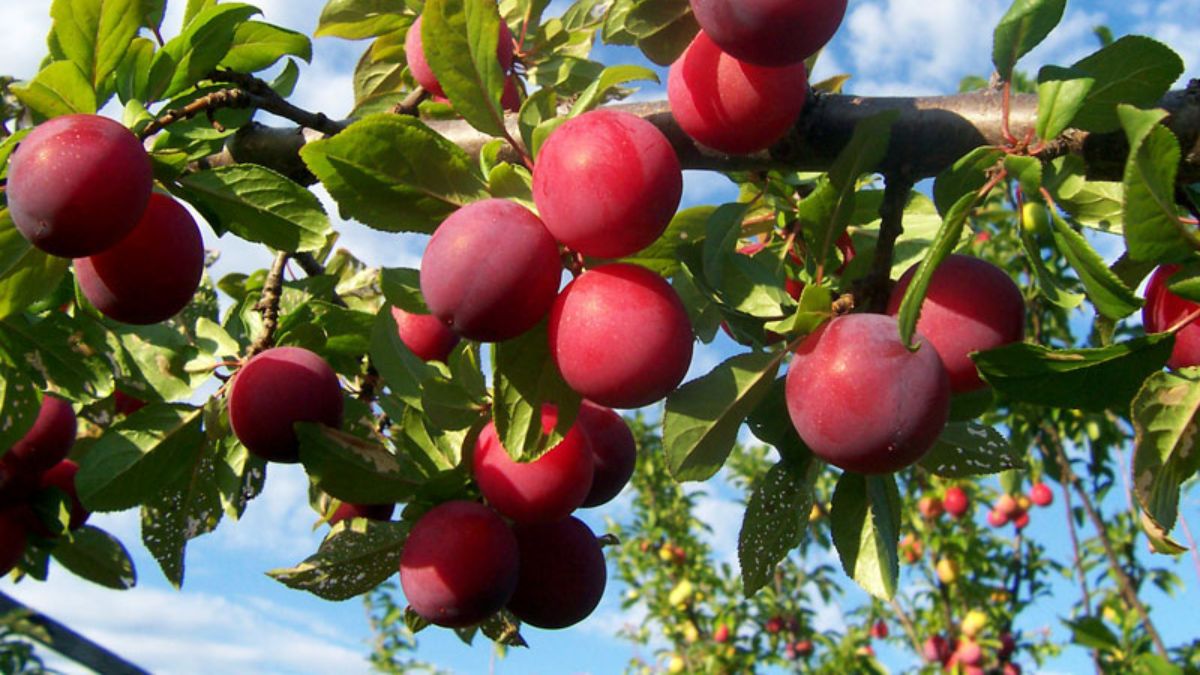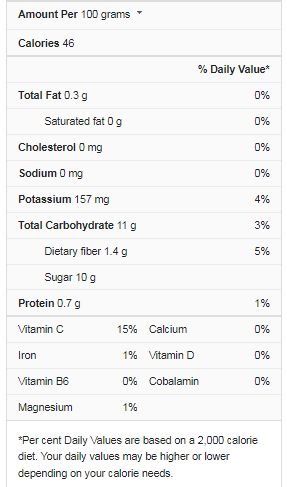Fat in total A plum has 0.2 grams of total fat, with.03 grams of polyunsaturated fat,09 grams of monounsaturated fat, 0 grams of saturated fat, and 0 grams of trans fat. Carbohydrates A plum has 11 grams of carbohydrates, 1.4 grams of fiber, and 10 grams of natural sugars. Protein, The protein content of one plum is 0.5 grams. Plums are classified as stone fruits because they have a fire pit (or stone) surrounded by soft, pulpy flesh and thin skin. There are roughly 20 different sorts, with the Japanese plum being the one we’re most familiar with from the supermarket.
The plum is a stone fruit found on the Prunus genus of trees. Plum can be green, red, purple, or yellow, depending on the variety, and all have smooth, edible skin and sweet flesh surrounding a pit. The fruit is grown worldwide, but commercial cultivation is concentrated in China, Romania, Serbia, and the United States. It’s a widely used component in cuisines worldwide, from Eastern Europe to Asia and North and South America. Plums can be eaten raw as a light and sweet snack. The fruit is most commonly used in baked foods or cooked to make jams and sauces for both sweet and savory dishes in the kitchen. Grilled, poached, roasted, or stewed options are also available.
Plum Nutrition Facts
What Are Plums?
The plum is a fruit produced by trees belonging to the Prunus genus, a rose family member. China, the Americas, and Europe are all home to the plant. The fruit is a drupe, which means it has a pit (or stone) in the center, like a peach or an apricot. Plum trees in good health produce many fruits, filling every branch and limb and often ripening all at once.
The plum comes in a variety of sizes, shapes, and colors. It can be divided into two major categories: round Japanese plums and oblong European plums. Because the fruit is dried to form prunes, European or Italian plums may be sold as sugar plum, Italian plum or prune, French prune, or simply “fresh prune.” Red plums, black plums (more of a dark purple tint), and yellow plums are the three types of Japanese plums. Underneath the skins of both black and yellow plums is a lump of amber-colored meat.
The plum’s skin is smooth and delicious, and it’s covered with a white powder called bloom. The flesh is juicy, and the inedible pit is removed when preparing the fruit. Plums can be roasted, boiled, grilled, poached, or stewed, and they’re a cheap fruit to boot.
Plum Health Benefits
Plums include vitamin C, which aids in wound healing, muscular growth, and blood vessel formation. It’s also good for your eyes.
Here are other ways that plums are good for your health:
Heart disease- Plums include phytochemicals and minerals that reduce inflammation linked to heart disease.
Anxiety- A plum a day could help keep anxiety at bay, and anxiety levels can rise when antioxidant levels are low.
Constipation Relief- Plums, like prunes, can help move things along in your digestive tract. Sorbitol, a sugar alcohol that works as a natural laxative, is abundant in them.
High blood pressure and stroke- Plums contain potassium, which is beneficial to blood pressure regulation in two ways. It aids in the removal of sodium from your body through urination and reduces tension in the walls of your blood vessels. Your chances of having a stroke are reduced when your blood pressure is lower.
Rich in antioxidants- These compounds protect the body from cell and tissue damage, leading to diabetes, Alzheimer’s, Parkinson’s, and cancer.
Reduce blood sugar- Plums are high in fiber, which helps to prevent blood sugar spikes following carbohydrate consumption. They can also help your body produce more adiponectin, a hormone that aids in blood sugar regulation.
Bone health. Prunes (dry plums) have been shown in animal studies to help decrease and even reverse bone loss.
How to Cook with Plums?
Plums can be eaten raw or cooked, and they can be used in various ways. Cakes, pies, and tarts are some of the baked foods that contain them. Plum jam, chutney, sauces for desserts, and savory meat meals are particularly popular. The fruit can be juiced to drink straight or fermented to make plum wine, and it can also be utilized in beverages like smoothies. When cooking with black plums, the dark peel gives the dish a lovely purple color.
Wash the outside of the plum well before using it in a dish. Cut the fruit into halves or quarters as directed in the recipe, then discard the pit. When you need to keep the plum’s general form for recipes like dumplings, slit it in half, cut along the pit, and remove it. Other recipes, such as boiling jams, will ask for diced plums. Plum halves and quartered plums can also be grilled or roasted and poached for a sweet fruit soup or compote.
Where to Buy Plums?
Most supermarkets and grocery stores have plums on hand when plums are in season. At some farmer’s markets, the fruit is also available. Plums are in season from the middle of summer to the beginning of autumn, and this will vary significantly depending on the climate, that is, the weather of the year and the variety. The plum is often affordable when purchased by the pound.
This delicate fruit should be handled with care to avoid bruising. Give a gentle squeeze to a plum while choosing one. It should only give a smidgeon, like a peach. There should be no soft areas or bruising on the skin, and it should be a lively hue. The skin of most plums has a bloom, which is a delicate dusty white matte powder that rubs or rinses off. This indicates ripe, freshly harvested fruit that has not been handled excessively.
How to Store Plums?
A ripe, ready-to-eat plum can be stored at room temperature. Wrap the fruit loosely in plastic and chill it to preserve it in good shape for a little longer. Allow a complex plum to soften by leaving it out at room temperature for a few hours. Please place it in a paper bag to speed up the process. Unlike some other fruits, a plum does not become sweeter as it ripens; once removed from the tree, it stops producing sugars.
Plums freeze well if you have too many to use right away. You can wash, peel, and put the plum if you wish. Cut it into smaller pieces, then freeze it in a single layer on a baking sheet for a few minutes before transferring it to an airtight container. Plum will last six months to a year in the freezer. The fruit is best used frozen in smoothies, baked items, or preserves.
Plum vs. Pluot
The pluot is a cross between a plum and an apricot, and it usually begins to ripen at the same time as the plum. Pluot is shaped and colored more like a plum than an apricot, yet it has a crisper feel than a plum. This is most noticeable when eating the fruit raw. However, pluot can be utilized in various plum recipes.
A pluot, sometimes known as a “Sweet Treat,” is a similar plum-apricot hybrid that bears both fruits equally. The exterior of this fruit is green, with spots of crimson flush from the sun (an apricot feature) and brilliant pink to red flesh inside. It’s a late-season variety with firm flesh that’s less prone to damage, making it suitable for chopped recipes, such as a plum salsa alternative.
What are the Varieties of Plum?
Plums are available in various colors, flavors, and textures, and some of the more common kinds are better suited to specific applications.
El Dorado is a popular black plum from Japan with golden flesh. It has a moderate, sweet plum flavor and holds its shape well when cooked, ideal for plum tarts. The Moyer plum is a wide, oblong European variety that is widely available. It can be eaten fresh or dry and is renowned for its sweet flavor. Another well-known European plum is damson.
Greengage plums are a type of green plum that is popular in France. It has greenish-yellow flesh with a honey-like flavor and a greenish-yellow skin. Mirabelle plums have the highest sugar content of any plum variety. In France, the little fruit with a subtle reddish flush is used to make eau-de-vie.
The skin of red plum types is brilliant crimson. Some have amber meat, like the Santa Rosa, while others, like the Sims, have brilliant red flesh that matches their skins. The tartness of the skin counteracts the sweetness of the fruit. These plums are tender when mature, making them one of the most delicate. Another standard red plum is Elephant Heart.
Conclusion
According to scientists, plums are the next “superfood” because they have antioxidant levels comparable to, if not higher than, blueberries. According to AgriLife Research researcher Dr. David Byrne, one plum contains almost the same antioxidants as a handful of blueberries. Plums. According to Jaclyn London, MS, RD, CDN, these late-summer favorites have only 7 grams of sugar and 30 calories per serving. The great thing about plums is that you can use them to make things like sugar-free jams and marmalade.


